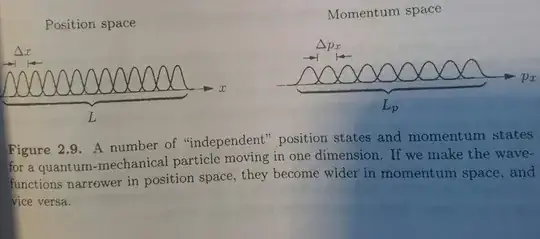I wrote an answer to this question on Distinct States, but I am not happy with the answer I gave to the short question at the end.
Hopefully this question is self contained, but please read the link above for full details, thanks.
The problem is set in momentum space, and deals with the multiplicity of a monotonic ideal gas. From my textbook:
The number of independent wavefunctions is finite, if the total available position space and momentum space are limited.
L/$\Delta x$ is the number of distinct position states and L$_p$/$\Delta p$ is the number of distinct momentum states, (in a 1 dimensional system). The total number of distinct states is the product:
$\frac {L} {\Delta (x)}$$\frac {L_p} {\Delta (p )}$ =$\frac {LL_p} {h}$
Using the uncertainty principle.
My question is, what does this physically represent?
I am fairly familiar with Q.M., it is the momentum space concepts in thermodynamics that I am just starting to study.
My interpretation is that it simply represents the fact the particle could be at any distinct position within the space, and can have a distinct momentum at that position. So $X = 5$, $P = 7$, or any other combination of these distinct variables.
I self study, (with no one else to check with, so please excuse the confirm my idea aspect). If it's as simple as that explanation, I shall be excruciatingly embarrassed, but at least happy that I have it sorted out.
